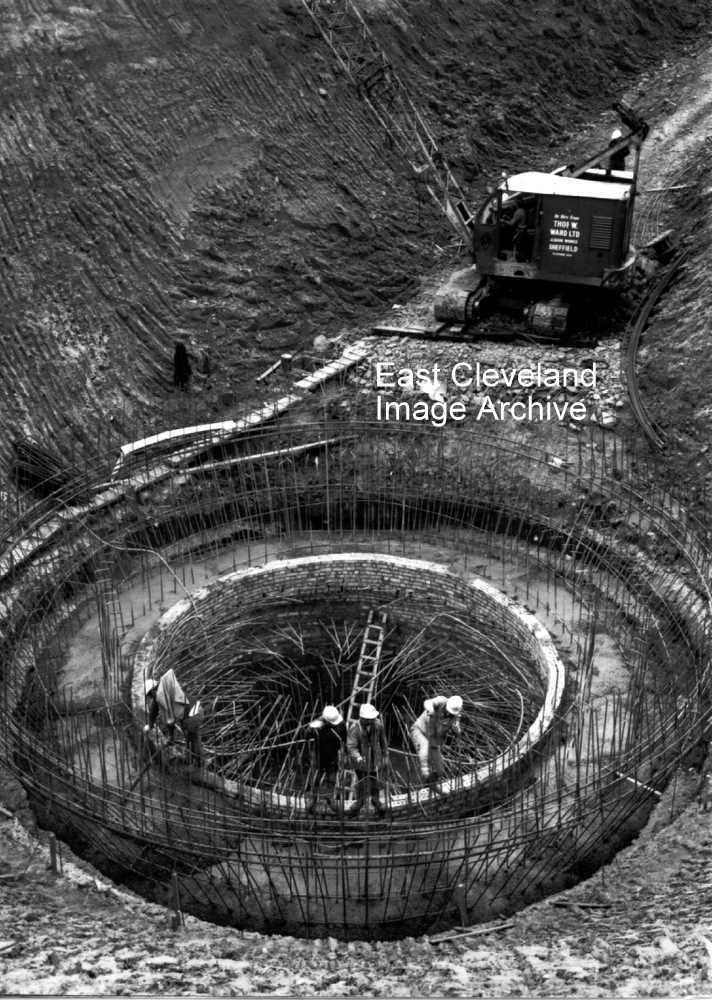
Another image of the shaft construction.
Image courtesy of Alan Franks.
|
|
||
|
Another image of the shaft construction.
It takes a lot of iron – is certainly true – to space the liner from the shaft. Another lovely industrial image, almost art! Image courtesy of Alan Franks.
Traditional skills, traditional tools, traditional methods. Men setting the shutter ready for concreting. They are measuring from a plumb line (there were 4; 1 at each point of the compass). Acrow Jacks were used to push the shutter into position. Image and words courtesy of Alan Franks.
Bet you thought it was all machine work; part of the record-breaking team of shaftmen at work. Showing concrete being poured through a metal pipe from the surface (visible to the right of the 1st man). These were called ’Elephant’s Trunks’ as they were short lengths linked together to make them flexible and they looked like an elephant’s trunk. The concrete was vibrated using a compressed air vibrating poker, to make sure the concrete was mixed properly to stop it honey combing, the man on the left is doing this.
An almost artistic industrial image of one of the shafts and a drilling machine.
Four young speed merchants if the caption is to be believed! We asked who are they and where are they? Derick Pearson believes the image was taken on Brotton Road in Carlin How: ”Looking from the entrance of the Carlin How ambulance station on Brotton Road; Stonehouse’s garage would be on the right and the second part of Brotton road would be to the left. The raised railtrack in the rear going to the left toward Crag Hall and Warsett hill.” We said we would like to have the identity of these ”speed kings”; Alan Franks tells us: “The young fellow on the right is my Dad, George Franks. Derick is probably right for the location, my Dad lived at Carlin How, first at Queen Street, then Brotton Road (Oxford Terrace then). His Dad, my Grandad worked on the Fab Shop and was killed there in 1924. His Mam lived with us until she died in1955, we lived in Redcar then.” Can anybody assist with any other names?
Double-headed by an Ivatt 3MT 2-6-2T number 41265 (a Whitby and Moors Excursion) rounds the reverse curve at Fen Bog, a few miles south of Goathland; the long train from the West Riding requiring assistance up the gradients out of Levisham. The second locomotive is probably a B1. This location is also close to Fylingdales Moor, sitting roughly below the radar station. Information adapted from comments courtesy of Mark.
Another view of the Tivoli Theatre, with a line of ”relaxed” gentleman seated outside. Anybody any ideas as to names? One suggestion from Kathleen Kelly is that the gentleman second from left could be Charles Biott? Image courtesy of the Pem Holliday Collection and Dot Verrill, with thanks to Kathleen Kelly for the update.
Despite it’s exotic title the Tivoli Theatre, Carlin How was actually a corrugated sheeting building; with it’s mock gothic windows bore a greater resemblance to a chapel or religious building. Remembered for its travelling shows and dandily dressed actors who performed there. The building was also used for balls, as well as auctions. It later burned down in a fire in December 1914, the fire was believed to have started in Biott’s fish and chip shop which stood at the other end of the Theatre. The Tivoli Theatre stood on what was commonly called the Common opposite but to the right of the school. The same area in later years was where the Air Raid shelters were built. The telephone box of more modern times would have been at the right hand end of the Tivoli looking from Carlin How Fisheries. The metal fencing in the image faced onto Kilton Lane, whilst the youngsters in the photograph would be looking across Muriel Street at the end of the Maynard Arms. Image courtesy of the Pem Holliday Collection and many thanks to Brian Jemson and Derick Pearson for updating information.
Another local commuter train underway, headed by a BR Standard tank, skirting the cliff edge at Kettleness. The unusual configuration of the first coach can be clearly seen in this image. A beautiful picturesque route, this would make a lovely leisure route today (after re-alignment to avoid the continuously advancing cliff edge!). Russ Pig0tt comments about the first carriage: “There’s nothing unusual about the first coach it is a Brake third, basically a second class coach (when built bizarrely there were only first and third class; second had been phased out) with guard’s accommodation and luggage space. Parcels and mail were still conveyed by trains such as this and continued on local services until the late 1980s.” Image courtesy Maurice Grayson and thanks to Russell Pigott for the clarification of the Editor’s query. |
||
Recent Comments